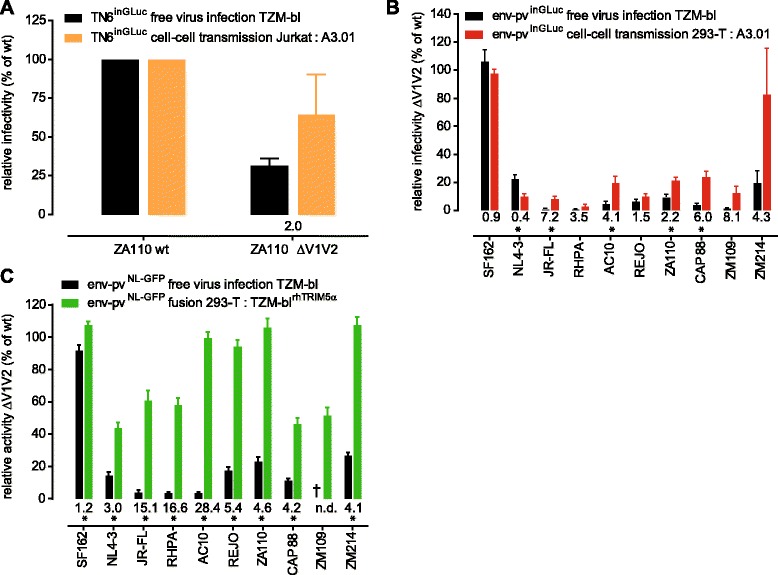Figure 3.

Higher tolerance towards loss of V1V2 during cell-cell transmission and cell-cell fusion compared to free virus infection. (A) Analysis of ZA110 wt and V1V2-deleted virus in T-cell to T-cell transmission using Jurkat donor cells (expressing replication competent TN6inGLuc reporter viruses) and A301-CCR5 target cells (orange). Cell-cell transmission activity was compared to free virus infectivity of the same Jurkat derived viruses on TZM-bl cells (black). Data are normalized to ZA110 wt. The relative efficacy of cell-cell transmission versus free virus infection of the V1V2 mutant is shown below the bars. Mean and SD from 2 independent experiments are depicted. (B) A panel of 10 wt and V1V2 deletion mutant pseudoviruses (env-pvinGLuc) were compared in free virus infection of TZM-bl cells (black) and in cell-cell transmission from 293-T cells to A3.01-CCR5 cells (red). ΔV1V2 env mutant infectivity is normalized to each corresponding wt env. Values of relative efficacy of cell-cell transmission versus free virus infection are shown below the bars; a star indicates whether this difference is statistically significant as probed by multiple unpaired t-tests with alpha = 0.05. Mean and SD from 3 independent experiments are depicted. (C) The same env panel as shown in (B) was tested for free virus infection (black) and cell-cell fusion (green). Strain ZM109 ΔV1V2 was not infectious as free virus on TZM-bl cells (marked by a cross). ΔV1V2 env mutant infectivity or fusion activity were normalized to each corresponding wt env. Values of relative efficacy of cell-cell fusion versus free virus infection are shown below the bars; a star indicates whether this difference is statistically significant as probed by multiple unpaired t-tests with alpha = 0.05. Mean and SD from 3 independent experiments performed in duplicates are depicted.
